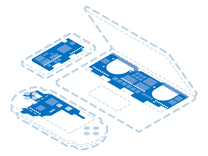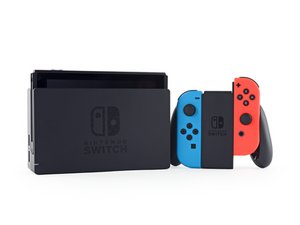First Steps
Before undertaking any of the more time-consuming solutions below, these are a few fundamentals to give a try.
- Be sure the model of the switch you’re using supports video output. The Switch Lite is intended for use only in handheld mode and is not compatible with the dock.
- Perform a hard power reset. Press and hold the Power button on the console for 30 seconds. Then press again to initiate a power-up sequence.
- If the issue is intermittent, try a software update. The software update setting can be found under System Settings > System > System Update.
- In addition to the overarching system update, update your dock’s firmware. The setting can be found in System Settings >System > Update Dock. You may need to do some reconnaissance to be able to navigate here since it will need to be in the dock to process the update.
- Verify the light on the dock is light solid green. This is an indication the Dock detects the switch and is outputting video to the connected display.
Causes
Although the Switch will typically output correctly without any additional configuration, unintentional changes can be made.
- On the Home screen, navigate to System Settings > TV Output. Make sure the TV Resolution is set to Auto or is set to a resolution your display supports. If you aren't certain, consult the manual for your TV or monitor.
It sounds silly, but the dock can be extremely particular about the order in which things are connected. If you’ve recently moved your dock, or have disconnected power since the last time you used it, make sure you follow these instructions in this exact sequence.
- Power off the TV and disconnect anything connected to the dock, or between the dock and the TV.
- Connect the USB C Power adapter to the dock.
- Connect HDMI to the dock.
- Connect HDMI to the TV.
- Dock your Switch.
- Power on the TV.
- Select the proper TV input.
If all is successful you should be getting a solid green light on the dock indicating the Switch is detected and outputting video.
Your issue may not be related to your Switch at all. There are many parts of the communication chain between your Switch and the connected display. You’ll need to test all of them to isolate the issue.
- Connect a known good device to the same HDMI input on the tv, using the HDMI cable previously connected to the Switch dock.
- If this is unsuccessful, try to isolate the failure. Connect the same known good device to a different input on the TV or use a different HDMI cable.
- If the device continues to function using the same input and HDMI cable as the Switch, move on to testing the Dock for function.
Once you’ve determined your display and cable function properly, it’s time to test the final link before getting to the Switch itself. The dock contains two points of connection that are important for the transmission of video signals.
- Verify you’re using the genuine Nintendo Dock. Although they are pricier, the Switch is fussy about connected USB C accessories. Using an OEM dock may resolve your issue.
- Inspect the HDMI port on the dock. Be on the lookout for bent pins or signs of deformation.
- With everything connected, gently wiggle the HDMI cable on the dock side. Attempt to find a position where video transmission is successful. If you can, there may be loose connections between the port and the board.
- If the HDMI port is faulty, the dock’s circuit board can be replaced. Make sure to get the correct part. The original Switch and Switch OLED have slightly different docks.
- Especially if the light on your dock won’t stay solid green, Verify it isn’t bent, or missing any pins. It can be difficult to see due to its location. Use a flashlight if necessary.
- You may need to use a plastic spudger or other tool to depress the spring-loaded protector that surrounds the port.
- If it is damaged, this part is also replaceable, but will require a bit more work to get at than the main dock board.

- 15 - 45 minutesModerate

- 20 - 30 minutesModerate
The USB C port on the bottom of the Switch serves a dual purpose. It acts as both the charge port and the interface for video output. Just because one function works properly does not guarantee the other does.
- Check to see if the USB C port is clean. Does a charger sit flush against the bottom edge? If it sits at an angle or has a loose fit, the port itself may be clogged. Use a flashlight to inspect.
- Removing debris from a USB C port can be a bit tricky due to its narrow gaps. Use an air duster and a toothpick shaved to fit to avoid damaging the port.
- Other non-conductive tools can be used in place of a toothpick, but avoid inserting anything metal into the port.
- Open the Switch and inspect for internal damage to the port, make sure it is attached soundly to the board, and free from burn or corrosion.
- Be aware there are some pins hidden by the port itself, so a clean visual bill of health is not a guarantee the port is sound.
- There is also a liquid damage indicator close to the port on the motherboard. This sticker turns solid red when it touches liquids.
- If you suspect your Switch may have water damage, you can use this motherboard replacement guide to get you inside to take a look. If the damage indicator shows up red, at least you're already halfway to completing the repair.
- Sadly, if you determine your port is the issue, it is not part of a modular replacement component. The port is soldered onto the board itself. If you do not have experience in microsoldering, ask around and see if any local repair shops offer this kind of repair. Otherwise, you will need to replace the entire board.
The motherboard is the hub for the vast majority of console functionality. Any number of the small components on the board may have failed or become damaged, and it's safe to assume a faulty motherboard is the cause if nothing else on this page has worked.
- Check for obvious signs of a board issue - burned or cracked components, liquid residue, corrosion, or bend. If there are signs of liquid the iPhone Liquid Damage Guide might help (this method applies to most circuit boards, not just iPhones).

- You can use this motherboard replacement guide to help get inside the device.
- Inspect closely around the PI3USB30532 chip on the rear side of the board. It handles the video output signals that travel through the USB port and its failure is a common cause for video output issues.
- Replacing the logic board is often the most practical solution for a DIYer in this position. If you see signs of liquid damage, this may be your best course of action.
- However, contrary to popular belief, the board itself can be repaired. It requires specialized tools and microsoldering know-how. This is not something most people can do themselves, but many independent repair shops can do it for you! Give your local electronics repair shop a call and chat about what they'd be able to do.

- 1 hourModerate

- 1 - 2 hoursModerate

Find compatible replacement parts for your Nintendo Switch. All parts and fix kits are backed by the iFixit Quality Guarantee.










